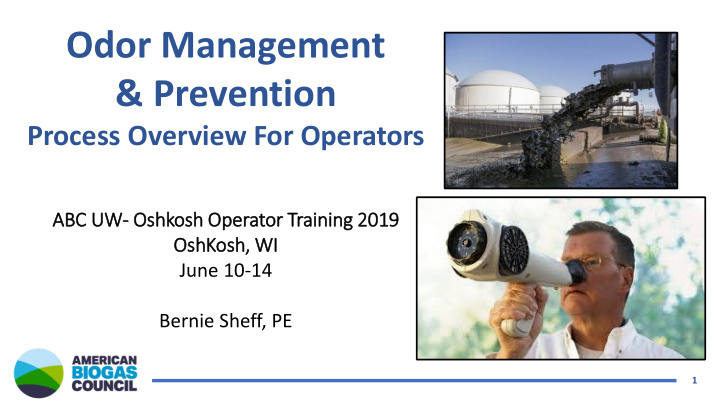



Odor Management & Prevention Process Overview For Operators AB ABC UW UW- Oshkosh sh O Oper perator Training 201 2019 Os OshKos osh, WI WI June 10-14 Bernie Sheff, PE 1
Odor Realities “The one commonality that you can find among all these odor management stories in organics recycling is we now live in a society that cannot tolerate inconvenience.“—Coker “IF YOU CAN SEE IT—YOU CAN SMELL IT” “Go take it head on. Engage it. Own it. Accept the fact that you’ve become a problem on these other folks and come up with a plan to fix it.“—Sheff 2
Iterative Process Several steps involved in avoiding, managing, and responding to odor concerns at anaerobic digestion facilities • Begins as early as site selection • Continues through design, modeling, engineering, and technology selection • Requires responsiveness to concerns with both technology and operations adjustments • Involves on-going monitoring and public outreach Odor Site Odor Engineering Operational Odor Abatement Selection Modeling Design Plans Monitoring Selection 3
Areas of Concern As with compost operations, studies have been completed to identify areas/actions of odor-causing concern across the physical/temporal actions of the facility. Key areas/actions of concern important to AD facilities include: • Transport/Manipulation/Storage of Feedstocks into the Facility • Choice of Feedstocks Processed at Facility • Quality of the Digestion Process • Processing/Storage/Transport of Digestate • Biogas Treatment/Upgrade • Unique Upset/Clean-Out Event 4
Inflow of Feedstocks to Site Technology — • Berms, landscaping, trees, etc. • Negative-air tipping buildings, closed receiving areas, hatches/doors, etc. • Scrubbing towers, carbon filters, air biofilters • Odor neutralizer systems, surfactants, organic acids, esters • Wash-down stations, effective drainage, etc. 5
Inflow of Feedstocks to Site Operations — • Keep facility clean at all times • Receiving trucks covered, clean, and hatches closed • Immediate wash-down of receiving site, closing of receiving stations • Odor-control checklist 6
Feedstock Choice • Not all substrates are equal , some are received already putrescent, particularly concentrated in sulfurs, ammonias, etc. • Should be assessed for digestion concerns, production, odor, variability, not just $. • Impact on all aspects of AD facility—pre, digestion, post, etc. 7
Quality of Digestion Improperly feed biological organism—upsets—incomplete digestion—odors • Proper design • Organic Loading Rate (OLR), Hydraulic/Solids Retention Time (HRT/SRT), mixing, temperature • Scum Control— particularly with FOG, seeds, etc. • Steady Feed— avoid large deviations in feedstock, federate, dilution, etc. 8
Post-Digestion Handling • Most likely solid/liquid separation—coarse and/or fine • Keep clean, move material, remove solids from anaerobic to aerobic setting • Additional control technologies— driers, pyrolysis, composting, covered tanks, etc. • Directly related to upstream operations —better job upstream, less odor on products. 9
Biogas Treatment • Avoid gas leakage— small level of leakage unavoidable, but minimize with design, good operations • Properly operating flares— good operating condition, backup power, proper design • Effective H 2 S control —Proper operation of H 2 S equipment • Properly working gas-use equipment —engines/scrubbers 10
Unique Upsets/Events Potential exists for unique, unexpected situations, such as biological upset, freezing weather, catastrophic loss of equipment, clean-outs, loss of power, etc. • Hard to anticipate, but important to have experience and effective responsiveness to such situations. 11
Odor Monitoring/Communication Some suggestions/ideas from the field: 1. Surveillance readings • Establish a protocol for odor collection at the facility perimeter using a meter • Some localized H 2 S monitoring at various points (tanks, biofilter, etc.) 2. Recording daily weather including wind speed and direction 3. Odor Complaint Handling • Odor complaint registration - in person, over the phone, or on the company website • Complaint response – documentation and testing • Take corrective actions as necessary • Document and communicate findings and results 12
Final Thoughts Odor issues (whether perceived or real) can and should be addressed Put in place best-in-class technology and processes – then use them! Focus on known spots of concern Engage with the community – early and often! Before, during, and after construction, and through on-going operations engage with the community and key stakeholders Continue outreach and ease of accessibility for questions or concerns Collect and monitor data – document readings, weather, steps taken, etc. 13
Recommend
More recommend